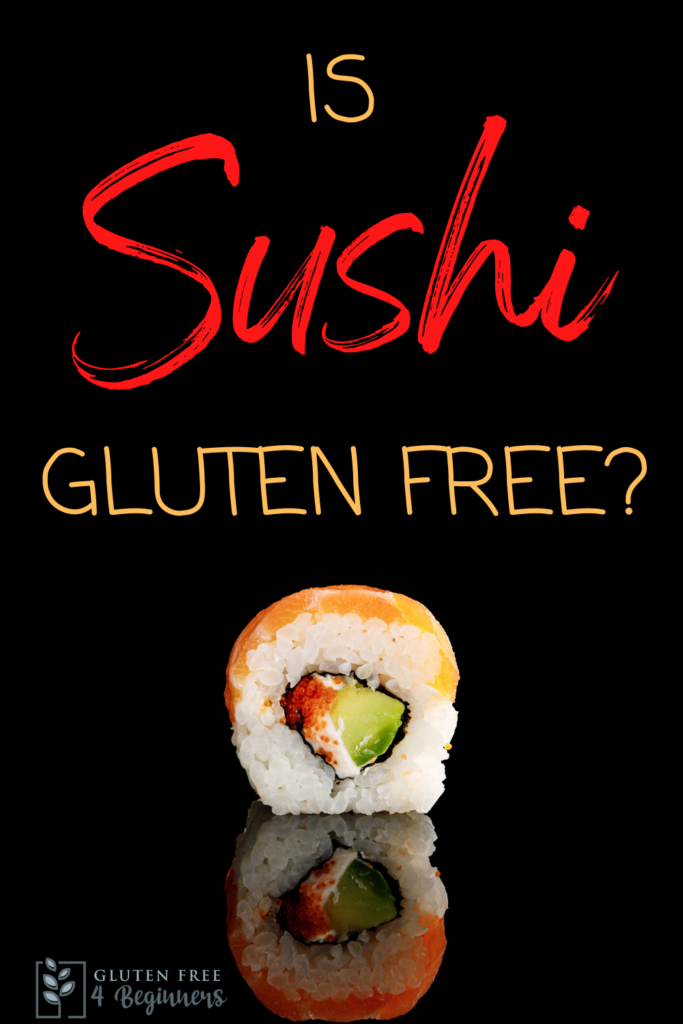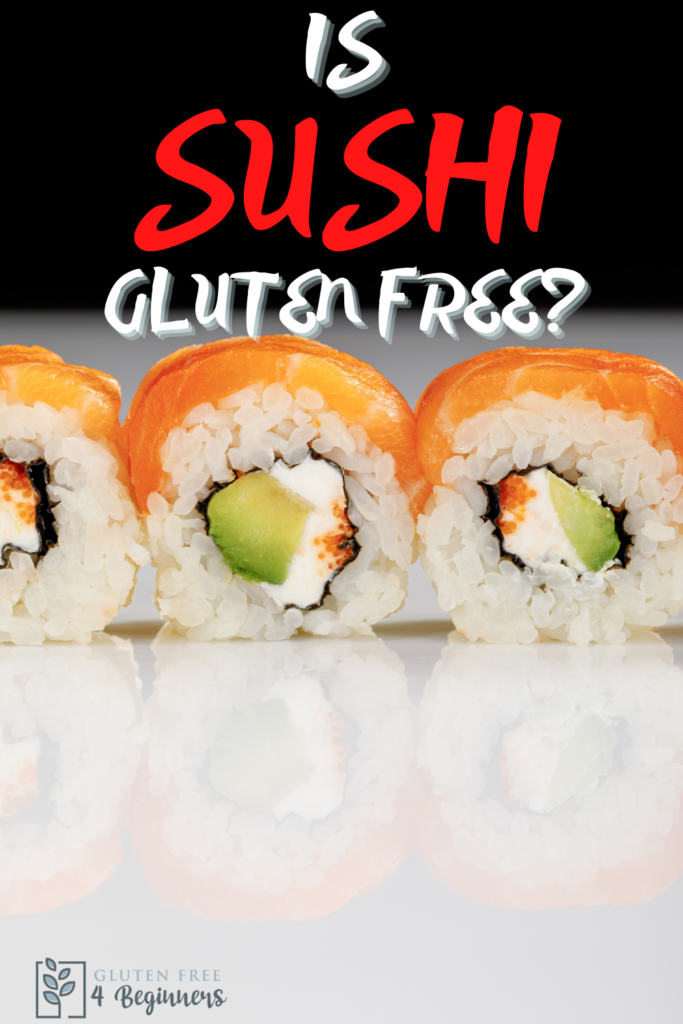Gluten Free Sushi

I never really considered sushi as a good gluten free option before moving to the west coast. Moving to the Pacific Northwest it seemed like sushi was everywhere. With a base of rice, I became intrigued and began to ask the question “Is sushi gluten free?”. I soon discovered that it wasn’t a simple yes or no answer. It was more of, sushi can be gluten free, if you are careful and selective in the types of fillings that are included in the sushi.
As a gluten free beginner this, ‘If’ can leave you confused, scared, and not sure where to start. But with a few simple concepts, you can easily navigate a sushi menu to find gluten free options. Below is a list of sushi ingredients to avoid or question and a list of gluten free sushi ingredients.
Hidden Sources of Gluten in Sushi
Knowing what to watch for or what sushi ingredients to question is the first step to enjoying gluten free sushi. The following sushi ingredients can be gluten free, but are often not gluten free.
Artificial Crab
Artificial Crab or imitation crab can contain gluten, depending on the brand or manufacturer. If the artificial crab packaging is not available to confirm that it is gluten free assume that it contains gluten.
Soy Sauce
Many soy sauce manufacturers include wheat in the fermentation of the soybeans to make the soy sauce. This inclusion of wheat makes soy sauce a very common hidden source of gluten. Thankfully there are many gluten free soy sauces available. Request a gluten free soy sauce with your sushi to avoid gluten contamination.
Wasabi
Is wasabi gluten free, is a common question and source of confusion. Pure wasabi is gluten free. However, imitation wasabi paste may contain wheat starch and is therefore not gluten free. It is difficult to distinguish the difference between real and imitation wasabi paste. While many brands of wasabi are gluten free, this is one ingredient where the ingredients must be verified to confirm it is gluten free.
Tempura
Tempura batter can be made gluten free but that is the exception not the rule. Unless the tempura is specifically labeled as gluten free assume that it is not and avoid tempura-coated fillings in your sushi selection. Even if the tempura is labeled as gluten free, confirmation is required to ensure a separate fryer is used to prevent cross-contamination.
Panko Battered and Fried Ingredients
Panko battered and other fried ingredients follow much the same rule as with tempura. If it is not labeled gluten free, assume it is not. Common to any type of fried food, a dedicated fryer should be used to avoid cross-contamination through the fryer oil.
Miso Marinade
Miso is made through the fermentation of soya beans and other grains. Similar to soy sauce, gluten free versions of miso are available. However, if it is not labeled gluten free it is safest to assume that the miso paste used in the miso marinade is not gluten free.
Teriyaki Sauces
Teriyaki sauces can be gluten free, but most often are not. With soy sauce as the main ingredient in Teriyaki sauce, the same rules for soy sauce apply to teriyaki, read the label or assume that it contains gluten.
Where Does Sushi Come From?
Sushi is Japanese in origin but like many foods, with international origins, it has been Americanized. Sushi has a base of rice that has been flavored with vinegar and sugar. This rice base forms the base of sushi in its many form and variations.
A California roll is a westernization of sushi not typically found in Japan but is one of the most popular and commonly found sushi rolls. Because a California roll is usually made with imitation crab, this is not a good choice for someone who is gluten free.
A commonly served sushi filling is salmon, this too is a Westernization of sushi. Salmon was not traditionally available in Japan. Salmon is a fantastic choice of filling for gluten free sushi.
Eating Out

While sushi begins with a common base of rice, the toppings, fillings, and presentation are not consistent and vary widely. The name for different types of sushi follows similar patterns in North America but what is included in each roll can vary widely. There is no universal way to determine what sushi is gluten free.
Our list of gluten free sushi ingredients and sushi ingredients to question can be used as a guide to ordering sushi that is gluten free when eating out.
One type of roll that I have had good luck with being gluten free is a spicy tuna roll. A spicy tuna roll typically is filled with raw tuna mixed with mayonnaise and sriracha.
Nigirizushi or hand-pressed sushi where a piece of fish is placed on top of a hand-formed portion of rice is a good option to consider for gluten free sushi.
In addition to sushi as a gluten free option, many restaurants specializing in sushi will also serve sashimi. Sashimi is also gluten free.
Gluten Free Sushi Ingredient Ideas
Having a list of safe ingredients to look for to help you navigate the search for gluten free sushi can be a total game changer. When going out for sushi or preparing to make it home these are gluten free sushi fillings to look for:
Tuna
Tuna is a very common gluten free sushi filling. Watch for contaminated sauces or marinades on the tuna, but tuna itself is gluten free.
Crab
Real crab is gluten free and is a delicious filling to have included in your sushi selection. As discussed above, imitation or artificial crab is not always gluten free. It is a good gluten free practice to confirm rolls with crab are real crab and not gluten imitation crab.
Salmon
While salmon may not be a traditional Japanese sushi filling, it is a great gluten free option to consider. As with tuna rolls watch for sauces and marinades that may not be gluten free.
Cucumber
Fish and seafood are not the only gluten free options for sushi fillings. Cucumber is a great gluten free sushi filling option to add a crunch to your sushi.
Avocado
Avocado is another gluten free vegetable option for sushi fillings. The rich creaminess of the avocado pairs beautifully with many common sushi fillings.
Roasted Sweet Potato
Continuing with veggie options for sushi filling, roasted sweet potato is a great gluten free option to add color and interest to the sushi rolls.
Sesame Seed Garnish and Flavoring
Sesame seeds are gluten free and add a complimentary nutty note to a sushi roll when used as a garnish. Both raw and toasted sesame seeds are gluten free as is sesame oil.
Daikon Radish
Prepared raw or pickled daikon radish or other radish varieties are gluten free.
Nori Sushi
Nori sushi is one of the most common types of sushi. Nori is gluten free. Nori sushi is made by rolling sushi rice and fillings in nori seaweed sheets. There are two basic variations of nori sushi, Norimaki and uramaki.
Norimaki
Norimaki is a nori sushi roll with the nori seaweed sheet on the outside of the roll. Rice and the other fillings are rolled inside of the nori.
Uramaki
Uramaki is a nori sushi with the nori sheet of seaweed on the inside of the roll and rice on the exterior. Uramaki is a westernized sushi creation. Typically, in a Uramaki roll the nori separates the fillings from the rice rolled on the exterior. Often sesame seeds will be used to garnish the otherwise plain white exterior of the Uramaki roll.
Recipe For Sushi Rice
Rice for sushi is easy to prepare to make sushi at home.
INGREDIENTS
- 2 Cups sushi rice
- 2 Cups Water
- ¼ cup Rice Vinegar
- 4 tsp Sugar
- 1 tsp Sea Salt
STEPS:
- The first step in making rice for sushi is to rinse the rice. Using cold water rinse the rice in a strainer until the water runs clear.
- Cook the rice in water until it is tender.
- Prepare the sushi vinegar while the rice is cooking.
- In a small saucepan heat the vinegar, salt, and sugar until the sugar is dissolved stirring with a whisk.
- When the rice is done cooking place it in a large bowl and season with the vinegar mixture, folding the rice to ensure even coverage of all the rice.
- Cover the bowl with a damp cloth or plastic wrap and set it aside to cool to room temperature. This can be sped up by placing the bowl of rice in the refrigerator.
- Use the cool sushi rice in the preparation of your gluten free sushi.
Sides to Serve with Sushi
Traditionally Sushi is served with soy sauce and wasabi. Pickled ginger is often provided to cleanse the pallet between pieces of sushi. Other dishes that are often served with sushi can include:
- Edamame
Edamame is commonly served with sushi. Edamame is gluten free and safe for those on a gluten free diet. These steamed soybeans add a nice pop of color to compliment sushi.
- Green Tea
Green tea is a traditional drink served with sushi. Green tea is gluten free and is a great choice of drink for a sushi meal.
- Cucumber Sesame Salad
A cucumber sesame salad is a wonderful accompaniment for sushi adding a bright fresh bite to the meal.
- Seaweed Salad
While it may not be for everyone, seaweed salad is commonly served alongside sushi.
- Tamagoyaki
Tamagoyaki is a Japanese omelet roll made primarily from eggs which are gluten free.
- Matcha Ice Cream
Matcha ice cream is the perfect dessert to serve following a sushi meal.
Final Thoughts About Gluten Free Sushi
I hope that these guiding concepts for gluten free sushi have inspired you to add sushi to your list of gluten free favorites as you begin to eat gluten free. Sushi is a great gluten free option, provided these basic principles are followed.



Leave a Reply